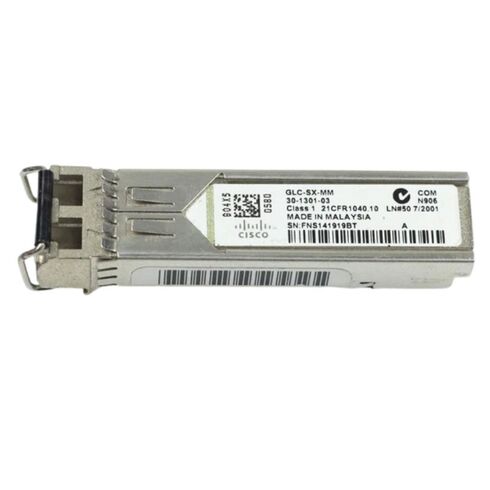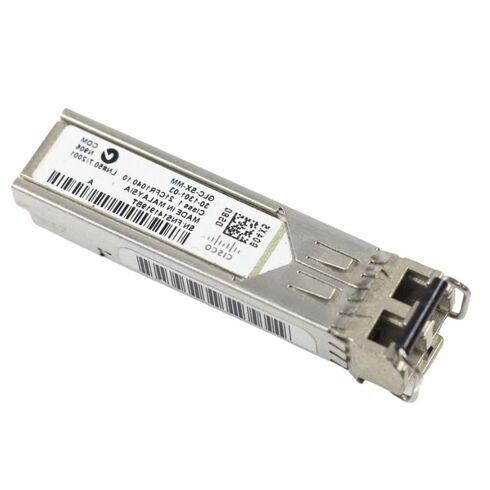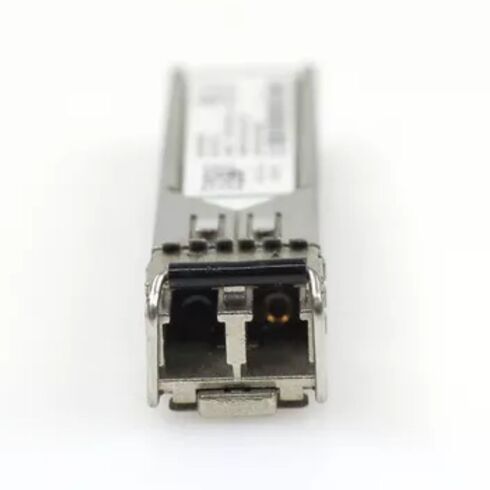GLC-SX-MM= Cisco GBIC-SFP Transceiver Module
- — Free Ground Shipping
- — Min. 6-month Replacement Warranty
- — Genuine/Authentic Products
- — Easy Return and Exchange
- — Different Payment Methods
- — Best Price
- — We Guarantee Price Matching
- — Tax-Exempt Facilities
- — 24/7 Live Chat, Phone Support
- — Visa, MasterCard, Discover, and Amex
- — JCB, Diners Club, UnionPay
- — PayPal, ACH/Bank Transfer (11% Off)
- — Apple Pay, Amazon Pay, Google Pay
- — Buy Now, Pay Later - Affirm, Afterpay
- — GOV/EDU/Institutions PO's Accepted
- — Invoices
- — Deliver Anywhere
- — Express Delivery in the USA and Worldwide
- — Ship to -APO -FPO
- — For USA - Free Ground Shipping
- — Worldwide - from $30
Same product also available in:
| SKU/MPN | Warranty | Price | Condition | You save |
|---|---|---|---|---|
| GLC-SX-MM= | 1 Year Warranty | $29.00 | Excellent Refurbished | You save: $10.15 (26%) |
| GLC-SX-MM= | 1 Year Warranty | $73.00 | Factory-Sealed New Retail in Original Box (FSB) | You save: $25.55 (26%) |
Cisco GLC-SX-MM= SFP Mini-GBIC Overview
General Information
- Manufacturer: Cisco
- Model Number: GLC-SX-MM=
- Product Type: SFP (Mini-GBIC)
Technical Specifications
Transceiver Module Details
- Type: 1000 Base-SX SFP (Mini-GBIC)
- Application: Data Networking
Interfaces and Ports
- Interface: 1 x 1000 Base-SX LAN
- Port Details: 1 x LC Duplex 1000 Base-SX Network LAN
Performance and Connectivity
- Connectivity Media:
- 50 µm Multi-mode Optical Fiber (1000 Base-SX)
- 62.5 µm Multi-mode Optical Fiber (1000 Base-SX)
- Data Transfer Rate: 1 Gbps Gigabit Ethernet
Compatibility
Compatible Devices
- Cisco 7304: Modular router supporting up to 4 line-rate 10 Gigabit Ethernet ports and 16 Gigabit Ethernet ports, designed for high-performance applications like service provider edge routing.
- Cisco 7301: High-performance router suitable for small to medium-sized networks, supporting up to 5 line-rate Gigabit Ethernet ports and a forwarding rate of 1 million packets per second.
- Cisco 12000: Modular router for service provider edge routing, offering up to 16 line-rate 10 Gigabit Ethernet ports and a forwarding rate of 320 Gigabits per second.
- Cisco CSS 11500: Content services switch designed for high-performance web and application traffic management, with up to 16 Gigabit Ethernet ports and a throughput of up to 48 Gbps.
- Catalyst 2940: Fixed-configuration switch ideal for small to medium-sized networks, featuring up to 24 10/100 Ethernet ports and basic Layer 2 switching capabilities.
- Catalyst 2950: Fixed-configuration switch for small to medium-sized networks, with up to 24 10/100 Ethernet ports and basic Layer 2 switching functions.
- Catalyst 3750: Stackable switch for medium to large-sized networks, supporting up to 48 10/100/1000 Ethernet ports and offering advanced Layer 2 and Layer 3 switching features.
- Catalyst 6500: Modular switch for large-sized networks, supporting up to 720 10/100/1000 Ethernet ports or up to 256 10 Gigabit Ethernet ports, providing advanced Layer 2 and Layer 3 capabilities and often used as a core switch in enterprise networks.
Compatibility
The Cisco GLC-SX-MM= Transceiver Module is designed to be compatible with a wide range of devices, making it a versatile and convenient option for users. One of the key compatibility features of this transceiver module is its support for GBIC-SFP, which stands for Gigabit Interface Converter-Small Form-factor Pluggable. GBIC-SFP is a standard that allows for hot-swappable, small form-factor pluggable transceivers to be used in a variety of networking devices.
Compatibility with Cisco Devices
Supported Routers
- Cisco 7304: Modular router for high-performance applications, supports up to 4 line-rate 10 Gigabit Ethernet ports and 16 Gigabit Ethernet ports.
- Cisco 7301: High-performance router suitable for small to medium-sized networks, supports up to 5 line-rate Gigabit Ethernet ports.
- Cisco 12000: Modular router for service provider edge routing, supports up to 16 line-rate 10 Gigabit Ethernet ports and 320 Gbps forwarding rate.
Supported Switches
- Cisco CSS 11500: Content services switch for managing web and application traffic, supports up to 16 Gigabit Ethernet ports with up to 48 Gbps throughput.
- Catalyst 2940: Fixed-configuration switch for small to medium-sized networks, provides up to 24 10/100 Ethernet ports.
- Catalyst 2950: Fixed-configuration switch for small to medium-sized networks, offers up to 24 10/100 Ethernet ports.
- Catalyst 3750: Stackable switch for medium to large networks, supports up to 48 10/100/1000 Ethernet ports with advanced Layer 2 and Layer 3 capabilities.
- Catalyst 6500: Modular switch for large networks, provides up to 720 10/100/1000 Ethernet ports or up to 256 10 Gigabit Ethernet ports with advanced switching features.
Benefits of GBIC-SFP Compatibility
Having GBIC-SFP compatibility provides several benefits to users:
Flexibility
By supporting GBIC-SFP, the Cisco GLC-SX-MM= Transceiver Module can be used in a wide range of networking devices, including switches and routers. This flexibility allows users to easily integrate the transceiver module into their existing network infrastructure without the need for additional equipment or modifications.
Interoperability
With GBIC-SFP compatibility, the Cisco GLC-SX-MM= Transceiver Module can seamlessly communicate with other networking devices that also support this standard. This ensures smooth data transmission and enhances overall network performance.
Cost-effectiveness
The ability to use the Cisco GLC-SX-MM= Transceiver Module with GBIC-SFP compatible devices eliminates the need for multiple types of transceivers. This can result in cost savings for businesses, as they only need to invest in a single type of transceiver module that can be used across different network devices.
Importance of GBIC-SFP Compatibility
GBIC-SFP compatibility is important for users due to the widespread adoption of this standard in the networking industry. Many networking devices, including those from Cisco, support GBIC-SFP modules. By choosing a transceiver module that is compatible with this standard, users can ensure seamless integration with their existing network infrastructure and avoid compatibility issues that could lead to downtime or suboptimal performance.
Speed
The Cisco GLC-SX-MM= Transceiver Module offers a speed of 1Gbps, which is essential for high-performance networking applications. This speed ensures fast data transfer and efficient communication between network devices.
Benefits of 1Gbps Speed
The 1Gbps speed of the Cisco GLC-SX-MM= Transceiver Module provides several benefits to users:
High Bandwidth
With a speed of 1Gbps, the transceiver module can handle large amounts of data simultaneously. This high bandwidth is crucial for modern networks that require fast data transfer for applications such as video streaming, cloud computing, and virtualization.
Reduced Latency
The fast speed of the Cisco GLC-SX-MM= Transceiver Module helps to minimize latency, which is the delay in data transmission. Low latency is essential for real-time applications like VoIP (Voice over Internet Protocol) and video conferencing, where even a slight delay can significantly impact the user experience.
Future-proofing
By offering a speed of 1Gbps, the Cisco GLC-SX-MM= Transceiver Module ensures compatibility with current and future networking standards. This future-proofing capability allows users to invest in a reliable and high-performance transceiver module that can support their evolving network requirements.
Importance of 1Gbps Speed
The importance of 1Gbps speed lies in its ability to meet the demands of modern networking applications. As technology continues to advance, the need for faster data transfer and higher bandwidth becomes increasingly crucial. By choosing a transceiver module with a speed of 1Gbps, users can ensure that their network infrastructure is capable of supporting current and future high-bandwidth applications.
Wavelength
The Cisco GLC-SX-MM= Transceiver Module operates at a wavelength of 850nm, which is a key specification for optical networking. The wavelength determines the frequency at which the transceiver module emits or receives light, allowing for efficient data transmission over optical fibers.
Benefits of 850nm Wavelength
The 850nm wavelength of the Cisco GLC-SX-MM=Transceiver Module offers several benefits:
Compatibility with Multi-mode Fiber
Multi-mode fiber optic cables are commonly used in short-range networking applications. The 850nm wavelength is specifically designed to work efficiently with multi-mode fiber, ensuring reliable and high-speed data transmission over shorter distances.
Improved Signal Quality
The 850nm wavelength provides better signal quality compared to other wavelengths in multi-mode fiber optic networks. This results in reduced signal degradation and improved overall network performance.
Standardization
The use of 850nm wavelength in multi-mode fiber optic networks is widely standardized, ensuring compatibility and interoperability with other networking devices and transceiver modules. This standardization simplifies the integration process and makes it easier for users to select compatible components for their network infrastructure.
Importance of 850nm Wavelength
The importance of the 850nm wavelength lies in its widespread adoption and compatibility with multi-mode fiber optic networks. Many networking devices and transceiver modules, including the Cisco GLC-SX-MM=, are specifically designed to operate at this wavelength. By choosing a transceiver module with an 850nm wavelength, users can ensure seamless integration and optimal performance in their multi-mode fiber optic networks.
Fiber Type
The Cisco GLC-SX-MM= Transceiver Module is designed for use with multi-mode fiber optic cables. The choice of fiber type is crucial as it directly affects the performance and capabilities of the transceiver module in specific networking environments.
Benefits of Multi-mode Fiber
Multi-mode fiber offers several benefits for users:
Cost-effectiveness
Compared to single-mode fiber, multi-mode fiber is generally more cost-effective. This makes it an attractive choice for short-range networking applications where the distance between network devices is limited.
Higher Bandwidth
Multi-mode fiber can support higher bandwidth compared to single-mode fiber. This is beneficial for applications that require fast data transfer and high-speed communication, such as data centers and multimedia streaming.
Easy Installation
Multi-mode fiber is easier to install and terminate compared to single-mode fiber. The larger core size of multi-mode fiber allows for simpler connections and reduces the complexity and cost associated with installation.
Importance of Multi-mode Fiber
The importance of multi-mode fiber lies in its suitability for short-range networking applications and its cost-effectiveness compared to single-mode fiber. By choosing a transceiver module designed for multi-mode fiber, such as the Cisco GLC-SX-MM=, users can ensure optimal performance and cost-efficiency in their network infrastructure.
Connector
The Cisco GLC-SX-MM= Transceiver Module features an LC (Lucent Connector) type connector. The choice of connector is important as it determines the ease of installation and compatibility with other networking devices.
Benefits of LC Connector
The LC connector provides several benefits for users:
Small Form-factor
The LC connector is smaller in size compared to other connectors such as SC (Standard Connector) or ST (Straight Tip). This compact size makes it ideal for high-density environments where space is limited, such as data centers or network cabinets.
Easy Installation
The LC connector features a push-pull mechanism, which allows for quick and easy insertion and removal of the transceiver module. This simplifies the installation process and reduces the risk of damage to the connector or the transceiver module.
Compatibility
The LC connector is widely adopted in the networking industry, making it compatible with a wide range of networking devices and transceiver modules. This standardization ensures seamless integration and interoperability with other components of the network infrastructure.
Importance of LC Connector
The importance of the LC connector lies in its small form-factor, ease of installation, and compatibility with other networking devices. By choosing a transceiver module with an LC connector, such as the Cisco GLC-SX-MM=, users can ensure convenient and reliable connectivity in their network infrastructure.
Distance
The Cisco GLC-SX-MM= Transceiver Module has a maximum distance of 550m, which refers to the maximum range over which the transceiver module can transmit and receive data without signal degradation.
Benefits of 550m Distance
The 550m distance capability of the Cisco GLC-SX-MM= Transceiver Module offers several benefits:
Flexibility in Network Design
With a maximum distance of 550m, the transceiver module provides flexibility in network design. It can be used in a variety of networking environments, from small office setups to large-scale data centers, without the need for additional equipment or modifications.
Cost-effectiveness
The ability to transmit data over a distance of 550m eliminates the need for expensive long-haul fiber optic cables or additional signal amplification equipment. This results in cost savings for businesses without compromising on network performance.
Reliable Signal Quality
The Cisco GLC-SX-MM= Transceiver Module ensures reliable signal quality over the maximum distance of 550m. This reduces the risk of data loss or signal degradation, ensuring consistent and high-performance data transmission.
Importance of 550m Distance
The importance of the 550m distance capability lies in its versatility and cost-effectiveness. By choosing a transceiver module with a maximum distance of 550m, such as the Cisco GLC-SX-MM=, users can ensure reliable connectivity over a wide range of networking environments without the need for expensive infrastructure upgrades.











